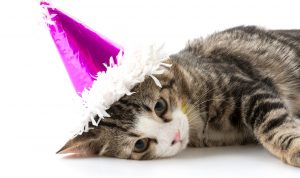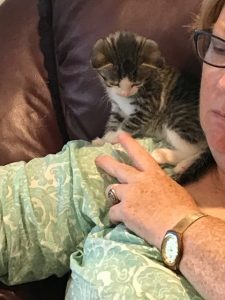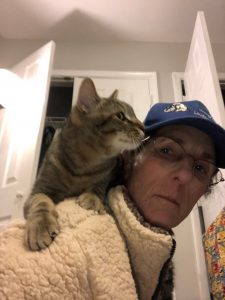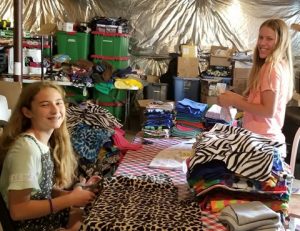

Serving as HSLC’s Director of Animal Operations, Donna contributed significantly to Virginia serving as a model for the No-Kill philosophy. Donna has rescued thousands of animals, fostered hundreds of animals, improved the lives of thousands of community cats, and relocated hundreds of working cats to safe properties. She opens her house to foster the toughest of dogs and the neediest of cats – all without breaking a sweat. She is the first to answer the call to pull an animal from being euthanized, and she’ll move heaven and earth to find a loving foster home. There is no doubt that Donna has made a lasting impact on animal rescue in Loudoun County, Virginia, and the East Coast – and on both animals and humans alike.
Donna shares her knowledge, passion, and extensive rescue network with other volunteers to amplify her impact. She is a heartfelt advocate and community educator on the importance of trap-neuter-return (TNR) for the health community cats. She often helps with community events and serves as a keynote speaker at volunteer orientations.
On top of all her above contributions, she finds more resources to help HSLC save more animal lives by writing grant applications to request funding and advertising volunteer job vacancies to recruit volunteers. She managed these resources while serving as the Vice President of the Board of Directors and, most recently, as a Member at Large.
Donna’s tireless spirit and efforts are truly inspirational. She sets the example that one person can truly make an impact on the world, and certainly in animal rescue. Although she is a vocal animal rescuer, Donna is humble in sharing her efforts and impact. There are few people who have saved as many animal lives in Loudoun County as Donna has, and she is overdue to receive recognition for her herculean efforts.

Serving as a HSLC volunteer since 2001, Juanita is one of HSLC’s longest serving volunteers. Juanita’s contributions over 20 years are staggering and inspirational. She has helped tens of thousands of animals find loving homes, helped feed tens of thousands of animals whose families were in need, developed and led Loudoun County’s only low-cost spay-neuter program for companion animals, and touched the lives of thousands of volunteers.
Juanita currently serves as HSLC’s President, Pet Pantry Lead, Education Lead, and Financial Assistance Lead. As President, she is the cornerstone of HSLC’s success. When HSLC struggled to find its footing in the 2010s, Juanita rejoined the board as President not only to save the organization but to make it flourish. Her leadership has enabled HSLC to thrive and serve as an animal rescue nonprofit leader in Virginia.
Juanita’s leadership with the Loudoun Pet Pantry (LPP) Program is extraordinary. Under her leadership, 27000+ pounds of food were distributed via Loudoun Hunger Relief to families in need in 2020, ensuring that 4400+ animals could been fed in Loudoun County. She goes above and beyond typical volunteer work, hosting HSLC’s contribution to the LPP in her own garage. On top of all her other duties, she organizes vibrant community events, processes financial and legal paperwork, and oversees content for newsletters and outreach.
Juanita has always been the heart of HSLC. Her humility, passion for animal welfare, generosity, and kindness are infectious, and the reason why so many volunteers continue supporting HSLC. She sets the example that one person can truly make an impact on the world, and certainly in animal rescue. Although she is a vocal educator on animal rescue and our volunteers’ loudest cheerleader, Juanita is beyond modest in celebrating her own accomplishments and impact. She is long overdue to receive recognition for her decades of heart-filled hard work and dedication.

In Amy’s own words, “I just want to do whatever I can to help.” That pretty much sums up Amy’s passion for animals and her very strong work ethic. Not only does she serve as the HSLC Foster Coordinator but she also drives the marketing of our adoptable animals. Her boundless creativity and energy have helped to make HSLC animals stand out and shine. She also played a key role in the success of the Giving Tuesday campaign gathering up success stories and photos that gave us an abundance of compelling content to work from. On top of that, her house is always swimming with new foster animals that she and her husband are caring for. HSLC is so very lucky to have Amy as one of our super pawsome volunteers!

Diane joined HSLC in 2016 and has since participated in virtually every program while also serving on the Board of Directors. From 2017-2020, Diane served as the Board Secretary where she transcribed and distributed board meetings, kept records of all HSLC accounts, and gave due notices of all meetings, among other duties. She is the administrative arm of HSLC and ensures that our animal care-focused volunteers have the organization, support, and resources needed to do their work.
In addition to her secretarial duties, Diane participates in most of our community and adoption events, feeds a feral cat community, and frequently fosters dogs for HSLC. She volunteers with the Loudoun Pet Pantry and orders microchips for our animals.
Diane’s herculean efforts and down-to-earth personality are inspirational. She sets the example that one person can truly make an impact on the world, and certainly in animal rescue. Diane is beyond humble and rarely speaks of the importance of her impact. She is one of the many invisible hands behind the scenes of HSLC, and she is overdue to receive recognition for her wide-reaching impact.

Ms. Pam Harvey is recognized for her superb work serving as the Adoption Program Lead. Pam single handedly managed all incoming adoption applications in 2020 which requires outstanding communication skills, responsiveness, and mastery of multitasking. Additionally, Pam demonstrates excellent judgement to ensure potential adopters share our dedication to providing our animals a happy and healthy forever home. Leveraging her expertise in animal rescue, she councils new adopters on how to introduce new pets to existing pets, how to introduce adoptees to a new home environment, what to expect when bringing a new pet home, and many other topics. Pam’s focus and dedication has resulted in a record number of adopted animals. Pam is truly invaluable, and HSLC sincerely appreciates Pam’s dedication to ensuring homeless animals find their forever homes.

Ms. Juli Bowman is recognized for her outstanding work serving as the HSLC Youth Volunteer Coordinator. Juli has single handedly served as the HSLC advisor for dozens of senior capstone projects, a youth animal rescue club, and numerous youth fundraising projects (e.g., bake sales). Her leadership has enabled youths to provide real impact in animal rescue, educated youths on humane treatment of animals, and instilled passion for volunteering in hundreds of youth. Her positivity, approachability, energy, creativity, and passion have been key to engaging the youth population in Loudoun County. Juli is an inspiration to HSLC volunteers, and HSLC sincerely appreciates Juli’s dedication to youth volunteers and to the animal rescue mission.

In October 2020, HSLC recognized Sam Hartmann, a youth volunteer and the first recipient of the HSLC Hero award. Sam’s contributions include assisting HSLC in various fundraiser events, recruiting other student volunteers, and even forming a club in Loudoun County High School named the LCHS Animal Rescue and Support Club. His initiative led to increased volunteer participation in animal rescue projects by his school peers. Sam also ran a pet food drive through the LCHS club. His energy and passion are highly commendable!
HSLC held the first virtual volunteer appreciation event on October 18, 2020 where we recognized Sam Hartmann for his outstanding work. He was presented with a certificate and a trophy by the President of HSLC, Juanita Easton, in the presence of Sam’s family members, LCHS English teacher and club sponsor – Kathryn Ives, HSLC Board Member Anne Senft, and the volunteer management team members – Christina Levendosky, Juli Bowman, and Sruthy Menon. It was a very joyous and proud moment for Sam. HSLC wishes Sam the best as he transitions to college and we hope that he continues to serve as an animal rescue advocate in the future.

This is Peggy. And, if we’re honest, Peggy has resting “witch” face. It’s not her fault, of course. But, many adopters overlook cats with inner beauty, like Peggy, in favor of the outwardly pretty kitties.
To add insult to injury, Peggy only has three legs. Actually, that’s not as bad as it sounds as many tripods get around pretty well. But, she will still need a forever family who is patient with her mobility issues.
When we rescued Peggy last May (yes, she’s been waiting that long to be adopted), she was hungry and in pain. Her leg and paw were broken and had to be amputated. Plus, she had just given birth a week before and was desperately trying to care for her kittens. Sadly, only two survived but they were immediately placed into foster care and adopted into a wonderful home.
After all she’s been through, Peggy definitely deserves a second chance at happiness. Unfortunately, she faces a lot of competition for attention. So, for special cats like Peggy, having a sponsor–aka Guardian Angel–can help improve the odds that they will find their purr-fect forever home.
How to get your wings
Making a direct and meaningful difference in the life of an animal in need will give you a warm and fuzzy feeling. And, it’s super easy to do. To become a Guardian Angel for Peggy or any of the animals in our care, please visit our donation page. In the dedication section, let us know which cat(s) you would like to sponsor. Through a one-time donation, you can cover the $150 adoption fee in part or full. If you are donating through a mobile device, the dedication field may not appear. In that case, simply send an email to anne@humaneloudoun.org and let us know which animal(s) you are sponsoring. Thank you!





